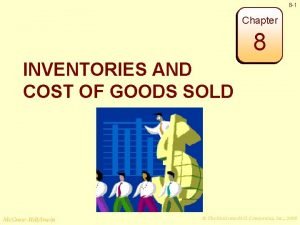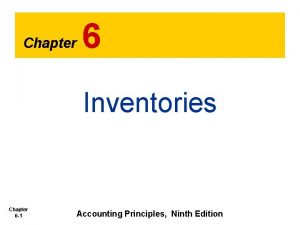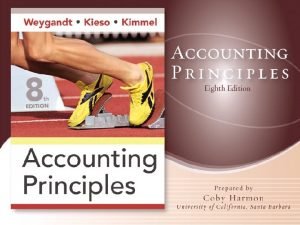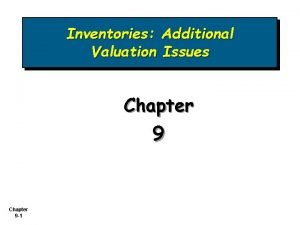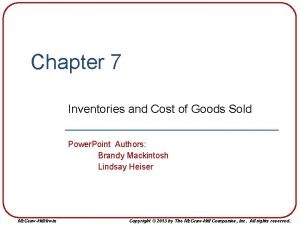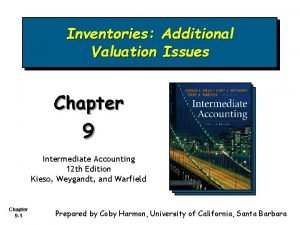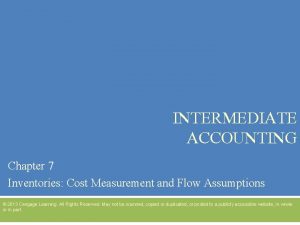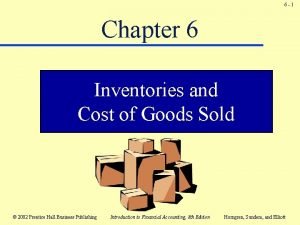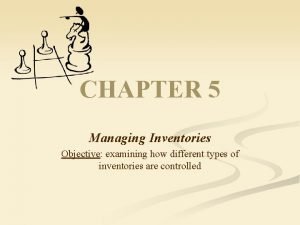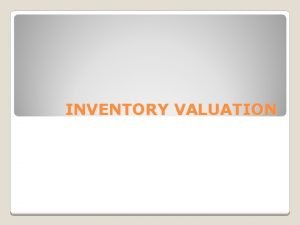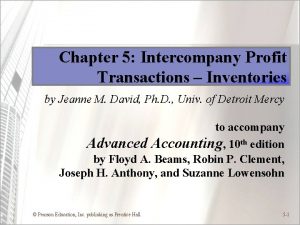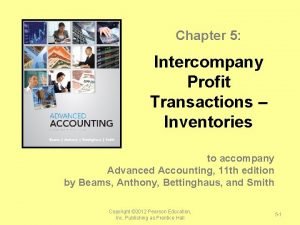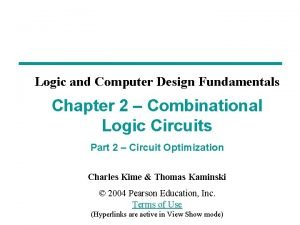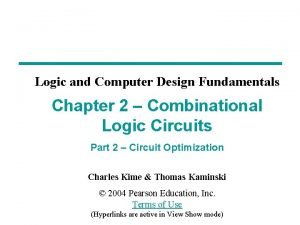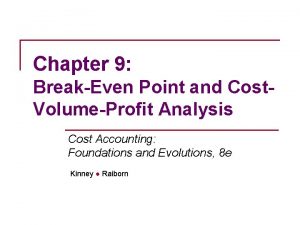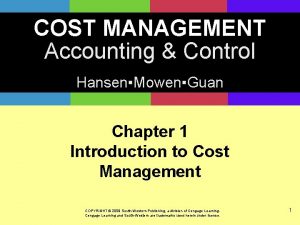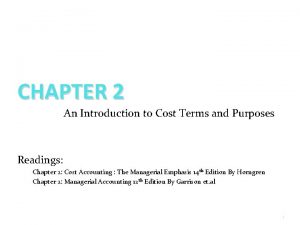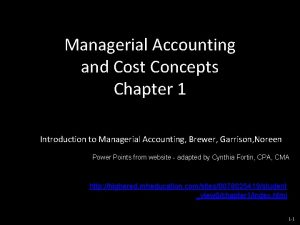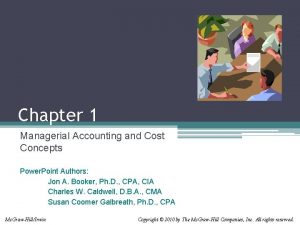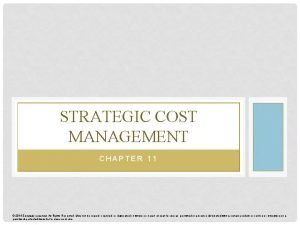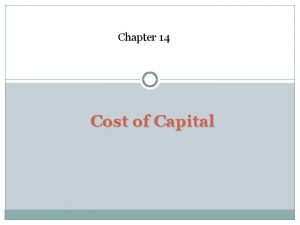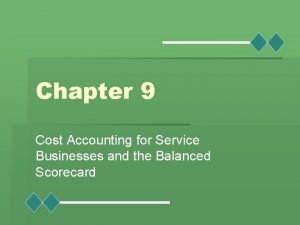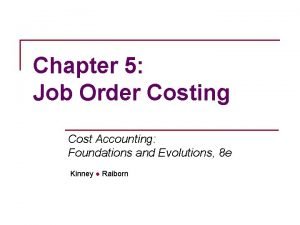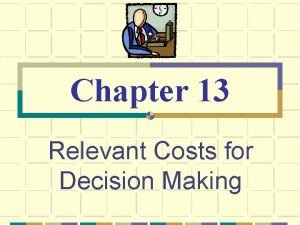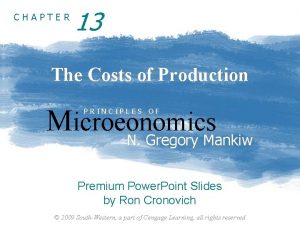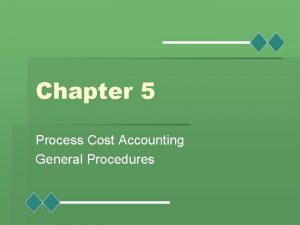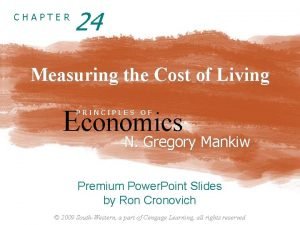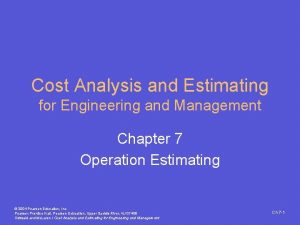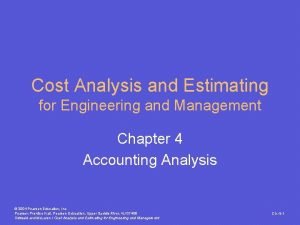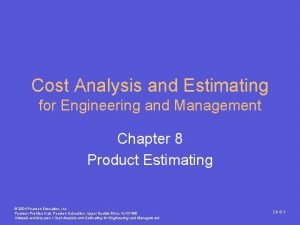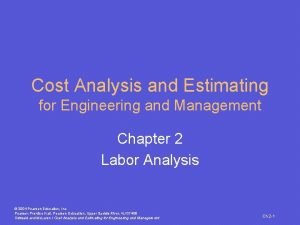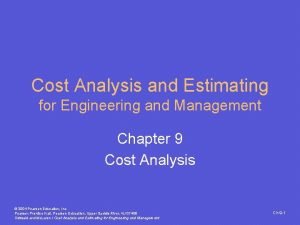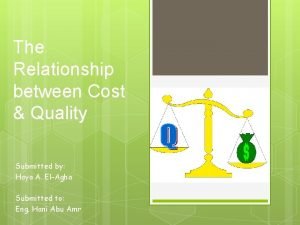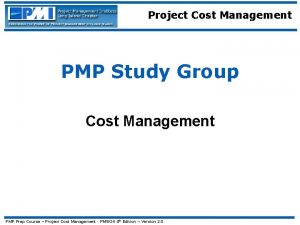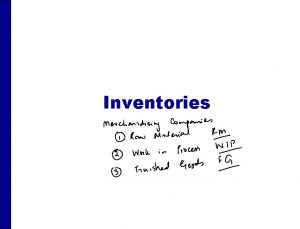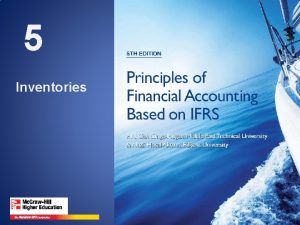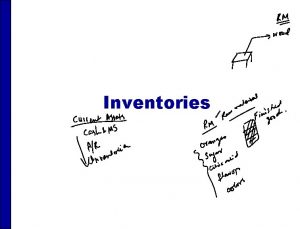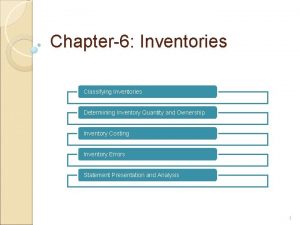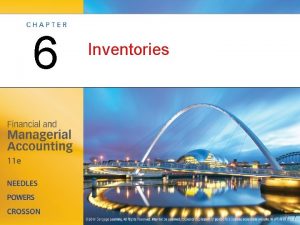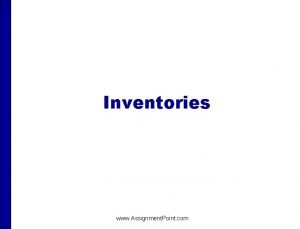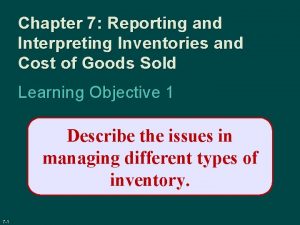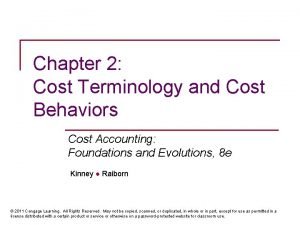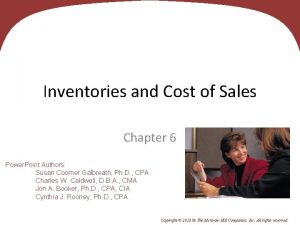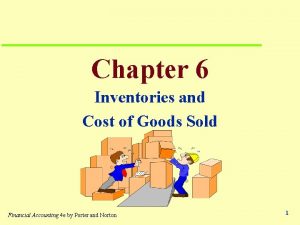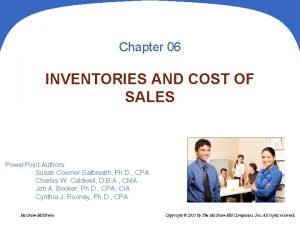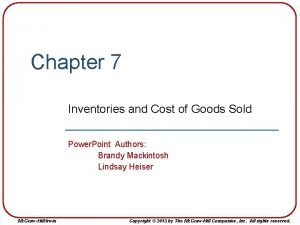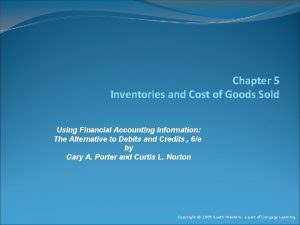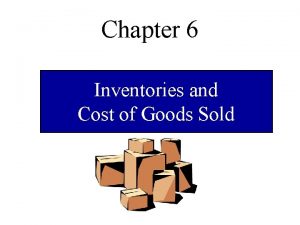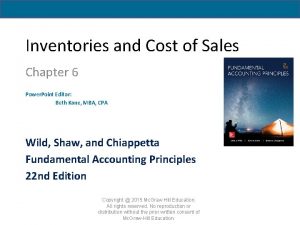8 1 Chapter 8 INVENTORIES AND COST OF




































































- Slides: 68

8 -1 Chapter 8 INVENTORIES AND COST OF GOODS SOLD Mc. Graw-Hill/Irwin © The Mc. Graw-Hill Companies, Inc. , 2008

8 -2 Inventory Defined Inventory Goods owned and held for sale to customers Mc. Graw-Hill/Irwin Current asset © The Mc. Graw-Hill Companies, Inc. , 2008

8 -3 The Flow of Inventory Costs BALANCE SHEET Purchase costs (or manufacturing costs) Asset Inventory INCOME STATEMENT as goods are sold Revenue Cost of goods sold Gross profit Expenses Net income Mc. Graw-Hill/Irwin © The Mc. Graw-Hill Companies, Inc. , 2008

8 -4 The Flow of Inventory Costs In a perpetual inventory system, inventory entries parallel the flow of costs. Mc. Graw-Hill/Irwin © The Mc. Graw-Hill Companies, Inc. , 2008

8 -5 Which Unit Did We Sell? When identical units of inventory have different unit costs, a question naturally arises as to which of these costs should be used in recording a sale of inventory. Mc. Graw-Hill/Irwin © The Mc. Graw-Hill Companies, Inc. , 2008

8 -6 Inventory Subsidiary Ledger A separate subsidiary account is maintained for each item in inventory. How can we determine the unit cost for the Sept. 10 sale? Mc. Graw-Hill/Irwin © The Mc. Graw-Hill Companies, Inc. , 2008

8 -7 Inventory Cost Flows We use one of these inventory valuation methods to determine cost of inventory sold. ge a r Ave st Co LIFO Mc. Graw-Hill/Irwin FIFO Specific Identification © The Mc. Graw-Hill Companies, Inc. , 2008

8 -8 Data for an Illustration The Bike Company (TBC) Mc. Graw-Hill/Irwin © The Mc. Graw-Hill Companies, Inc. , 2008

8 -9 Specific Identification When a unit is sold, its specific cost is added to cost of goods sold. Mc. Graw-Hill/Irwin © The Mc. Graw-Hill Companies, Inc. , 2008

8 -10 Specific Identification On August 14, TBC sold 20 bikes for $130 each. Of the bikes sold 9 originally cost $91 and 11 cost $106. Mc. Graw-Hill/Irwin © The Mc. Graw-Hill Companies, Inc. , 2008

8 -11 Specific Identification The Cost of Goods Sold for the August 14 sale is $1, 985, leaving $515 and 5 units in inventory. Let’s look at the entries for the Aug. 14 sale. Mc. Graw-Hill/Irwin © The Mc. Graw-Hill Companies, Inc. , 2008

8 -12 Specific Identification Retail (20 × $103) Cost A similar entry is made after each sale. Mc. Graw-Hill/Irwin © The Mc. Graw-Hill Companies, Inc. , 2008

8 -13 Specific Identification Cost of Goods Sold for August 31 = $2, 610 Additional purchases were made on August 17 and 28. Costs associated with sales on August 31 were as follows: 1 @ $91, 3 @ $106, 15 @ $115, & 4 @ $119. Mc. Graw-Hill/Irwin © The Mc. Graw-Hill Companies, Inc. , 2008

8 -14 Specific Identification Income Statement COGS = $4, 595 Balance Sheet Inventory = $1, 395 Mc. Graw-Hill/Irwin © The Mc. Graw-Hill Companies, Inc. , 2008

8 -15 Specific Identification Not really. Specific identification is hard to use when we sell a lot of inventory that has lots of different costs. Mc. Graw-Hill/Irwin Since specific identification is so easy, can’t we use it all the time? © The Mc. Graw-Hill Companies, Inc. , 2008

8 -16 Average-Cost Method When a unit is sold, the average cost of each unit in inventory is assigned to cost of goods sold. Cost of Goods Units on hand Available for ÷ on the date of Sale sale Mc. Graw-Hill/Irwin © The Mc. Graw-Hill Companies, Inc. , 2008

8 -17 Average-Cost Method The average cost per unit must be computed prior to each sale. $2, 500 25 = $100 On August 14, TBC sold 20 bikes for $130 each. Mc. Graw-Hill/Irwin © The Mc. Graw-Hill Companies, Inc. , 2008

8 -18 Average-Cost Method The average cost per unit is $100. Mc. Graw-Hill/Irwin $100 = $2, 500 25 Let’s look at the entries for the Aug. 14 sale. © The Mc. Graw-Hill Companies, Inc. , 2008

8 -19 Average-Cost Method Retail Cost A similar entry is made after each sale. Mc. Graw-Hill/Irwin © The Mc. Graw-Hill Companies, Inc. , 2008

8 -20 Average-Cost Method Additional purchases were made on August 17 and August 28. On August 31, an additional 23 units were sold. Mc. Graw-Hill/Irwin © The Mc. Graw-Hill Companies, Inc. , 2008

8 -21 Average-Cost Method $114 = $3, 990 35 Mc. Graw-Hill/Irwin © The Mc. Graw-Hill Companies, Inc. , 2008

8 -22 Average-Cost Method The average cost per unit is $114. Mc. Graw-Hill/Irwin $114 = $3, 990 35 © The Mc. Graw-Hill Companies, Inc. , 2008

8 -23 Average-Cost Method Income Statement COGS = $4, 622 Balance Sheet Inventory = $1, 368 $114 × 12 = $1, 368 Mc. Graw-Hill/Irwin © The Mc. Graw-Hill Companies, Inc. , 2008

8 -24 First-In, First-Out Method (FIFO) Oldest Costs of Goods Sold Recent Costs Ending Inventory Mc. Graw-Hill/Irwin © The Mc. Graw-Hill Companies, Inc. , 2008

8 -25 First-In, First-Out Method (FIFO) The Cost of Goods Sold for the August 14 sale is $1, 970, leaving $530 and 5 units in inventory. On August 14, TBC sold 20 bikes for $130 each. Mc. Graw-Hill/Irwin © The Mc. Graw-Hill Companies, Inc. , 2008

8 -26 First-In, First-Out Method (FIFO) Retail Cost A similar entry is made after each sale. Mc. Graw-Hill/Irwin © The Mc. Graw-Hill Companies, Inc. , 2008

8 -27 First-In, First-Out Method (FIFO) Additional purchases were made on Aug. 17 and Aug. 28. On August 31, an additional 23 units were sold. Cost of Goods Sold for August 31 = $2, 600 Mc. Graw-Hill/Irwin © The Mc. Graw-Hill Companies, Inc. , 2008

8 -28 First-In, First-Out Method (FIFO) Income Statement COGS = $4, 570 Balance Sheet Inventory = $1, 420 Mc. Graw-Hill/Irwin © The Mc. Graw-Hill Companies, Inc. , 2008

8 -29 Last-In, First-Out Method (LIFO) Recent Costs of Goods Sold Oldest Costs Ending Inventory Mc. Graw-Hill/Irwin © The Mc. Graw-Hill Companies, Inc. , 2008

8 -30 Last-In, First-Out Method (LIFO) The Cost of Goods Sold for the August 14 sale is $2, 045, leaving $455 and 5 units in inventory. On August 14, TBC sold 20 bikes for $130 each. Mc. Graw-Hill/Irwin © The Mc. Graw-Hill Companies, Inc. , 2008

8 -31 Last-In, First-Out Method (LIFO) Retail Cost A similar entry is made after each sale. Mc. Graw-Hill/Irwin © The Mc. Graw-Hill Companies, Inc. , 2008

8 -32 Last-In, First-Out Method (LIFO) Additional purchases were made on Aug. 17 and Aug. 28. On Aug. 31, an additional 23 units were sold. Mc. Graw-Hill/Irwin © The Mc. Graw-Hill Companies, Inc. , 2008

8 -33 Last-In, First-Out Method (LIFO) Cost of Goods Sold for August 31 = $2, 685 Mc. Graw-Hill/Irwin © The Mc. Graw-Hill Companies, Inc. , 2008

8 -34 Last-In, First-Out Method (LIFO) Income Statement COGS = $4, 730 Balance Sheet Inventory = $1, 260 Mc. Graw-Hill/Irwin © The Mc. Graw-Hill Companies, Inc. , 2008

8 -35 Mc. Graw-Hill/Irwin © The Mc. Graw-Hill Companies, Inc. , 2008

8 -36 The Principle of Consistency Once a company has adopted a particular accounting method, it should follow that method consistently rather than switch methods from one year to the next. Mc. Graw-Hill/Irwin © The Mc. Graw-Hill Companies, Inc. , 2008

Just-In-Time (JIT) Inventory Systems 8 -37 This inventory arrived just in time for us to use it in the manufacturing process. Mc. Graw-Hill/Irwin © The Mc. Graw-Hill Companies, Inc. , 2008

8 -38 Taking a Physical Inventory The primary reason for taking a physical inventory is to adjust the perpetual inventory records for unrecorded shrinkage losses, such as theft, spoilage, or breakage. Mc. Graw-Hill/Irwin © The Mc. Graw-Hill Companies, Inc. , 2008

8 -39 LCM and Other Write-Downs of Inventory Obsolescence Lower of Cost or Market (LCM) Mc. Graw-Hill/Irwin Reduces the value of the inventory. Adjust inventory value to the lower of historical cost or current replacement cost (market). © The Mc. Graw-Hill Companies, Inc. , 2008

8 -40 LCM and Other Write-Downs of Inventory Mc. Graw-Hill/Irwin © The Mc. Graw-Hill Companies, Inc. , 2008

8 -41 Goods In Transit A sale should be recorded when title to the merchandise passes to the buyer. F. O. B. shipping point title passes to buyer at the point of shipment. Mc. Graw-Hill/Irwin Year End F. O. B. destination point title passes to buyer at the point of destination. © The Mc. Graw-Hill Companies, Inc. , 2008

8 -42 Periodic Inventory Systems In a periodic inventory system, inventory entries are as follows. Note that an entry is not made to inventory. Mc. Graw-Hill/Irwin © The Mc. Graw-Hill Companies, Inc. , 2008

8 -43 Periodic Inventory Systems In a periodic inventory system, inventory entries are as follows. Mc. Graw-Hill/Irwin © The Mc. Graw-Hill Companies, Inc. , 2008

8 -44 Periodic Inventory Systems The inventory on hand the cost of goods sold for the year are not determined until year-end. Mc. Graw-Hill/Irwin © The Mc. Graw-Hill Companies, Inc. , 2008

8 -45 Periodic Inventory Systems We use one of these inventory valuation methods in a periodic inventory system. Specific identification Average cost FIFO LIFO Mc. Graw-Hill/Irwin © The Mc. Graw-Hill Companies, Inc. , 2008

Information for the Following Inventory Examples Mc. Graw-Hill/Irwin 8 -46 © The Mc. Graw-Hill Companies, Inc. , 2008

8 -47 Specific Identification By reviewing actual purchase invoices, Computers, Inc. determines that the 1, 200 mouse pads on hand at year-end have an actual total cost of $6, 400. Determine the cost of goods sold for the year. Mc. Graw-Hill/Irwin © The Mc. Graw-Hill Companies, Inc. , 2008

8 -48 Specific Identification Cost of Goods Sold $9, 725 - $6, 400 = $3, 325 Mc. Graw-Hill/Irwin © The Mc. Graw-Hill Companies, Inc. , 2008

8 -49 Average-Cost Method The average cost is calculated at yearend as follows: Total Cost of Goods Available for Sale Mc. Graw-Hill/Irwin ÷ Total Number of Units Available for Sale © The Mc. Graw-Hill Companies, Inc. , 2008

8 -50 Average-Cost Method Avg. Cost $9, 725 1, 800 = $5. 40278 Ending Inventory Avg. Cost $5. 40278 1, 200 = $6, 483 Cost of Goods Sold Avg. Cost $5. 40278 600 = $3, 242 Mc. Graw-Hill/Irwin © The Mc. Graw-Hill Companies, Inc. , 2008

8 -51 First-In, First-Out Method (FIFO) Oldest Costs of Goods Sold Recent Costs Ending Inventory Mc. Graw-Hill/Irwin © The Mc. Graw-Hill Companies, Inc. , 2008

8 -52 First-In, First-Out Method (FIFO) Remember: Start with the 11/29 purchase and then add other purchases until you reach the number of units in ending inventory. Mc. Graw-Hill/Irwin © The Mc. Graw-Hill Companies, Inc. , 2008

8 -53 First-In, First-Out Method (FIFO) Now, we have allocated the cost to all. Now, 1, 200 let’s units complete the in ending inventory. table. Mc. Graw-Hill/Irwin © The Mc. Graw-Hill Companies, Inc. , 2008

8 -54 First-In, First-Out Method (FIFO) Completing the table summarizes the computations just made. Mc. Graw-Hill/Irwin © The Mc. Graw-Hill Companies, Inc. , 2008

8 -55 Last-In, First-Out Method (LIFO) Recent Costs of Goods Sold Oldest Costs Ending Inventory Mc. Graw-Hill/Irwin © The Mc. Graw-Hill Companies, Inc. , 2008

8 -56 Last-In, First-Out Method (LIFO) Remember: Start with beginning inventory and then add other purchases until you reach the number of units in ending inventory. Mc. Graw-Hill/Irwin © The Mc. Graw-Hill Companies, Inc. , 2008

8 -57 Last-In, First-Out Method (LIFO) Now, we have allocated the cost to all 1, 200 units in ending inventory. Mc. Graw-Hill/Irwin Next, let’s complete the table. © The Mc. Graw-Hill Companies, Inc. , 2008

8 -58 Last-In, First-Out Method (LIFO) Completing the table summarizes the computations just made. Mc. Graw-Hill/Irwin © The Mc. Graw-Hill Companies, Inc. , 2008

Importance of an Accurate Valuation of Inventory 8 -59 An error in ending inventory in a year will result in the same error in the beginning inventory of the next year. Mc. Graw-Hill/Irwin © The Mc. Graw-Hill Companies, Inc. , 2008

8 -60 For interim financial statements, we may need to estimate ending inventory and cost of goods sold. Mc. Graw-Hill/Irwin © The Mc. Graw-Hill Companies, Inc. , 2008

8 -61 The Gross Profit Method Determine cost of goods available for sale. Estimate cost of goods sold by multiplying the net sales by the cost ratio. Deduct cost of goods sold from cost of goods available for sale to determine ending inventory. Mc. Graw-Hill/Irwin © The Mc. Graw-Hill Companies, Inc. , 2008

8 -62 The Gross Profit Method In March of 2007, Matrix Company’s inventory was destroyed by fire. Matrix normal gross profit ratio is 30% of net sales. At the time of the fire, Matrix showed the following balances: Mc. Graw-Hill/Irwin © The Mc. Graw-Hill Companies, Inc. , 2008

8 -63 The Gross Profit Method Step 1 Step 2 × 70% Step 3 Mc. Graw-Hill/Irwin © The Mc. Graw-Hill Companies, Inc. , 2008

8 -64 The Retail Method The retail method of estimating inventory requires that management determine the value of ending inventory at retail prices. In March of 2007, Matrix Company’s inventory was destroyed by fire. At the time of the fire, Matrix’s management collected the following information: Mc. Graw-Hill/Irwin © The Mc. Graw-Hill Companies, Inc. , 2008

8 -65 The Retail Method Matrix would follow the steps below to estimate their ending inventory using the retail method. Mc. Graw-Hill/Irwin © The Mc. Graw-Hill Companies, Inc. , 2008

8 -66 Financial Analysis Measures how quickly a company sells its merchandise inventory. Average Inventory = (Beginning Inventory + Ending Inventory) ÷ 2 A ratio that is low compared to competitors suggests inefficient use of assets. Mc. Graw-Hill/Irwin © The Mc. Graw-Hill Companies, Inc. , 2008

8 -67 Financial Analysis Measures how many days on average it takes to sell its inventory. Mc. Graw-Hill/Irwin © The Mc. Graw-Hill Companies, Inc. , 2008

Accounting Methods Can Affect Financial Ratios 8 -68 Remember that identical companies that use different inventory methods (e. g. , FIFO and LIFO) will have different inventory turnover ratios. Mc. Graw-Hill/Irwin © The Mc. Graw-Hill Companies, Inc. , 2008
 Chapter 8 inventories and the cost of goods sold
Chapter 8 inventories and the cost of goods sold Chapter 6 inventories
Chapter 6 inventories Chapter 6 inventories
Chapter 6 inventories Chapter 9 inventories additional valuation issues
Chapter 9 inventories additional valuation issues Cost of goods sold formula
Cost of goods sold formula Lower-of-cost-or-market
Lower-of-cost-or-market Inventory intermediate accounting
Inventory intermediate accounting Chapter 6 inventories
Chapter 6 inventories Formal and informal assessment
Formal and informal assessment Non recycled inventory examples
Non recycled inventory examples Wac inventory
Wac inventory Juloidian inventories
Juloidian inventories Selective inventory management
Selective inventory management Intercompany profit transactions inventories
Intercompany profit transactions inventories Intercompany inventory transactions
Intercompany inventory transactions Smarter inventories
Smarter inventories Cost accumulation and cost assignment
Cost accumulation and cost assignment Cost accumulation and cost assignment
Cost accumulation and cost assignment Cost pools
Cost pools Cost accumulation and cost assignment
Cost accumulation and cost assignment Cost control and cost reduction difference
Cost control and cost reduction difference Standard costs meaning
Standard costs meaning Distinguish between average cost and marginal cost
Distinguish between average cost and marginal cost Cost control and cost reduction difference
Cost control and cost reduction difference Job-order-costing-vs-process-costing
Job-order-costing-vs-process-costing Ordering cost and carrying cost
Ordering cost and carrying cost Opportunity costs and trade offs
Opportunity costs and trade offs Cost control and cost reduction project report
Cost control and cost reduction project report Cost control and cost reduction project report
Cost control and cost reduction project report Cost structure refers to the relative proportion of
Cost structure refers to the relative proportion of Manufacturing cost vs non manufacturing cost
Manufacturing cost vs non manufacturing cost Job costing vs. process costing
Job costing vs. process costing Whats financial leverage
Whats financial leverage Controllable expenses examples
Controllable expenses examples Manufacturing cost vs non manufacturing cost
Manufacturing cost vs non manufacturing cost Standard cost variance
Standard cost variance Cost of equity
Cost of equity Literal cost gate input cost
Literal cost gate input cost Literal cost gate input cost
Literal cost gate input cost Literal cost gate input cost
Literal cost gate input cost Break-even sales formula
Break-even sales formula Cost and management accounting chapter 1
Cost and management accounting chapter 1 An introduction to cost terms and purposes
An introduction to cost terms and purposes Chapter 1 managerial accounting and cost concepts
Chapter 1 managerial accounting and cost concepts Chapter 1 managerial accounting and cost concepts
Chapter 1 managerial accounting and cost concepts Chapter 11 strategic cost management
Chapter 11 strategic cost management Basic assumptions of cvp analysis
Basic assumptions of cvp analysis Chapter 14 cost of capital
Chapter 14 cost of capital Cost accounting chapter 9
Cost accounting chapter 9 Chapter 5 job order costing solutions
Chapter 5 job order costing solutions Chapter 3 cost control
Chapter 3 cost control Relevant cost for decision making solution chapter 13
Relevant cost for decision making solution chapter 13 Cost accounting chapter 16
Cost accounting chapter 16 Chapter 13 the cost of production
Chapter 13 the cost of production Strategic cost management chapter 1
Strategic cost management chapter 1 Cost accounting chapter 5
Cost accounting chapter 5 Chapter 24 measuring the cost of living
Chapter 24 measuring the cost of living Cost analysis and estimating for engineering and management
Cost analysis and estimating for engineering and management Cost analysis and estimating for engineering and management
Cost analysis and estimating for engineering and management Cost analysis and estimating for engineering and management
Cost analysis and estimating for engineering and management Cost analysis and estimating for engineering and management
Cost analysis and estimating for engineering and management Cost analysis and estimating for engineering and management
Cost analysis and estimating for engineering and management Trade off definition economics
Trade off definition economics The relationship between quality and cost
The relationship between quality and cost Cost focus and differentiation focus
Cost focus and differentiation focus Resource aggregation in project management
Resource aggregation in project management Pmp cost management
Pmp cost management Menus recipes and cost management
Menus recipes and cost management Multinational cost of capital and capital structure
Multinational cost of capital and capital structure
